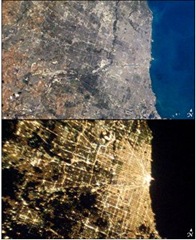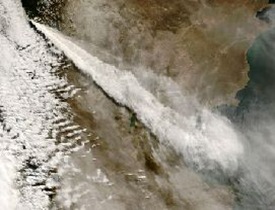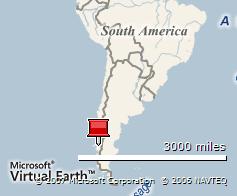
Where’s the brightest place on Earth – the place that is illuminated most when the Sun has gone down? New York’s Times Square perhaps… what about the glow of office lights around London’s business district… or maybe the bustling heart of Mumbai, the world’s most populated city. They’re all pretty bright, but of course nothing could beat the flashing, colorful sea of lights that make up Las Vegas – the brightest place on Earth.
 NASA has just released some new images of our planet at night, and I think it’s really fascinating to see what they tell us about our civilization.
NASA has just released some new images of our planet at night, and I think it’s really fascinating to see what they tell us about our civilization.
Until not long ago, most of Saudi Arabia was a vast desert, void of human habitation. But now its cities are bustling, and as their population increases, so does its brightness. I love the little strip of light connecting Jeddah and Mecca in the photo on the right – that’s the tiny but well-illuminated road linking the two cities.
 It’s also really interesting comparing cities by day and night. The photo on the left is Chicago – as soon as darkness comes the gray and brown sea of buildings is turned into a mass of light, coming from every building, road and shop.
It’s also really interesting comparing cities by day and night. The photo on the left is Chicago – as soon as darkness comes the gray and brown sea of buildings is turned into a mass of light, coming from every building, road and shop.
So how did NASA get these photos? It’s not as easy as you’d think – you have to bear in mind that the ISS (where these photos were snapped from) moves about 7 miles a second above Earth, and combined with the long exposure times necessary for such a dark photo, it’s difficult to avoid getting blurry photos, as any photographer will know.
The solution was to create a camera mount that rotated really slowly, to compensate the movement of the ISS. The result: beautiful pictures showing the amazing things humanity is capable of.
The only problem is that sometimes our lights go too far – many city-dwellers can’t see more than a handful of stars because artificial lighting lights up the sky so much. I’d really recommend looking at the International Dark-Sky Association‘s website – they’ve got loads of tips about how to reduce light pollution. But before that, just appreciate how fascinating our planet looks when it’s dark.
Filed under: Environment, Exploration, Nature, Science, Space, Technology | Tagged: artificial light, artificial lights, astronomy, chicago, civilization, Earth, humanity, jeddah, light, lights, mecca, NASA | 13 Comments »









.jpg/240px-Saturn_from_Cassini_Orbiter_(2004-10-06).jpg)


